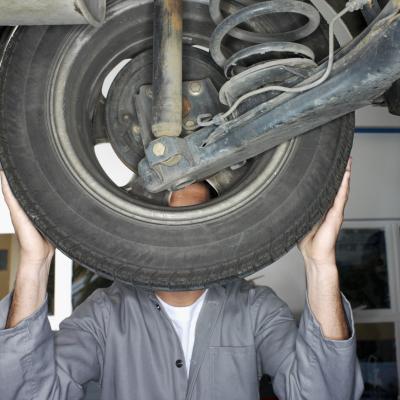
The terms “strut” and “shock absorber” are interchangeable in the minds of many car owners, but this is a misconception. The strut is a compact but complex assembly of parts that handles shock absorption in cars, including the eponymous absorber. It also includes the coil spring and its seats, the strut bearing and the steering assembly connection. Noises from the strut assembly invariably indicate some service or component replacement is urgently required.
The spring supports the static weight of the vehicle so that the body assembly remains elevated above the axles and the wheels can turn. When the vehicle is in motion. the springs expand and contract as its mass passes over road irregularities. This would result in a wild ride without some form of dampener; the shock absorber performs this function. It moderates the spring’s compression-rebound cycles so the sensation is the familiar one of gentle vertical drift rather than repeatedly slamming from the top to the bottom of the spring and back again. The top of the strut housing is attached to the upper strut bearing, the bottom to the steering knuckle via a bracket on the knuckle. These two swivel points allow the strut assembly to move with the road wheels when they are turned by the steering assembly.
The strut assembly's shock absorber cartridge loses its resiliency over time. This is usually so incremental a process that the regular driver fails to notice it. For this reason, a check of the strut assembly should be made once a year when the alignment of the front wheels is tested. Excessive wear will present in exaggerated bouncing when the vehicle passes over, for instance, a speed control hump or a deep drainage gulley; the springs may even bottom out at either end of the bounce. A more dangerous result can be body roll or drifting to one side or the other under harsh braking, nose-diving and increased stopping distances. Cupping wear can present on the tires. All are potentially dangerous.
Worn components also become obvious with odd new sounds from the car. Wear in the strut assembly is indicated if a thumping sound passes through the whole vehicle when it bottoms out hitting a bump or passing over a declivity such as a sunken manhole cover. The same is true if a similar noise can be heard under hard acceleration if the car is powerful enough to spin its tires. First check the strut bearings for wear; this is a cheaper fix than replacing the struts that make up the strut assembly. With the vehicle stationary and at idle, turn the wheel to its fullest locks. If the clunking is heard, the bearings have failed; if the turns are smooth and silent but the clunks are heard in motion over bumps and dips, the strut assembly should be inspected.
The need to replace the struts may point to aging coil springs as well. As professional service is typically required to replace either, it is normally cost-effective to replace both components at the same time.